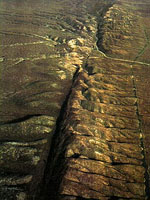
|
||||||||||||||||
|
|

|
||
What's at fault?
|
||
|
There are three main types of faults, based on how adjacent blocks of rock move relative to each other. The San Andreas Fault—made infamous by the 1906 San Francisco earthquake—is a strike-slip fault. This means two fault blocks are moving past each other horizontally. Strike-slip faults tend to occur along the boundaries of plates that are sliding past each other. This is the case for the San Andreas, which runs along the boundary of the Pacific and North American plates. After a quake along a strike-slip fault, railroad tracks and fences can show bends and shifts. And, of course, the motion can cause bridges and buildings to collapse. With both normal and reverse faults, movement occurs vertically. A normal fault is usually associated with plates that are diverging. Tension weakens the crust until the rock fractures, and one block of rock moves downward relative to the other. A reverse fault is usually associated with plates that are colliding. Compression forces a fault block upward. A thrust fault is a special kind of reverse fault where one or more plates are under the ocean. At a thrust fault, a plate below the sea is moving under another plate, thrusting its edge upward. The process of one plate diving under the other is called subduction. Thrust faults can produce larger earthquakes than strike-slip faults. The fault that caused the Sumatra earthquake and tsunami in December 2004 was this sort of fault. Rock may seem brittle, but it’s actually quite elastic. By studying the 1906 earthquake, scientists learned that this ability of rock to stretch and store energy like a spring is what enables earthquakes to happen. Earthquakes are now explained by the elastic rebound theory, which goes something like this: Stress is applied to rock or to an existing fault over a period of time. This usually happens at a plate boundary where two plates are moving in different directions, or in the same direction at different speeds. As the stress builds, strong rock or a locked fault (a fault where the two sides are held together by friction) deform elastically. Eventually, the stress overcomes the rock's strength or the fault's friction, and either the rock fractures or the fault slips. The energy that's released sets an earthquake in motion. The rock or fault rebounds, and the process may begin again. |
||
Live Eye • Great Shakes • Quake Basics • Damage Control • Active Zone



